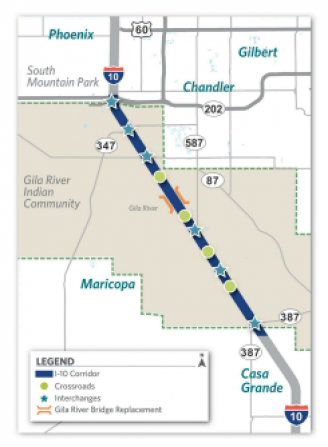Governor Katie Hobbs Announces $95 Million Federal Grant for I-10 Expansion
News Release
Governor Stephen Roe Lewis, Senator Sinema, Senator Kelly, Congressman Stanton, Congressman Gallego, and Congressman Grijalva join in celebrating historic funding for critical infrastructure project
PHOENIX - Today, Governor Katie Hobbs announced that Arizona will receive a $95 million INFRA grant from the US Department of Transportation for major improvements to widen Interstate 10. The grant was awarded to improve the safety and conditions on the 26-mile stretch of the I-10 located entirely within the boundaries of the Gila River Indian Community. The I-10 corridor is a main corridor for all Arizonans, with parts of this project area seeing up to 120,000 vehicles daily. This 26-mile stretch of the I-10 is the only remaining “gap, or unimproved section of the I-10, which creates bottlenecks and traffic delays for all who travel this section of the I-10. Obtaining funding for this project was a top priority for Governor Katie Hobbs, the Gila River Indian Community, the Arizona Congressional delegation, and the Arizona State Legislature, and was made possible through coordination between Governor Hobbs, GRIC Governor Stephen Roe Lewis, and the Arizona Department of Transportation.
This grant represents a unique partnership of governments, involving State, federal, tribal, and county governments in the planning and development of the grant to address the safety and infrastructure needs in Arizona and within the Gila River Indian Community.
“The I-10 serves as a major connector for the entire state, and I am thrilled to announce that we have secured the funds necessary to ensure it remains a gateway for generations to come,” said Governor Katie Hobbs. “By securing this investment, we are not only improving our state’s infrastructure, we are propelling Arizona’s economy forward, ensuring a prosperous future for all. I want to thank Governor Lewis for his tireless advocacy and our federal partners for helping make this possible.”
“The announcement today,” said Governor Lewis, “is the culmination of a year-long effort to obtain the final funding necessary to complete this critical part of the State’s, and the Community’s, transportation network. When we learned last year that Arizona would not be receiving a federal grant for this project, I immediately contacted Governor Hobbs, and together we rolled up our sleeves and got this new grant proposal together, focusing largely on the importance of this road to our Community, and we presented it together to Secretary Buttigieg, a first in our State, and probably in the entire country. I want to personally thank Governor Hobbs for her partnership in this effort and the Department of Transportation for its understanding and commitment to historically disadvantaged communities in Indian Country, such as ours. I also think it is very important to thank our allies and partners in the State Legislature who provided critical additional funding to help fill the gap and advocated right alongside us in Washington for this new grant. Finally, I have to say a word about the tireless advocacy for this grant by our federal delegation, especially Senators Sinema and Kelly, and our House members, Representatives Gallego and Stanton. They were immediate and constant supporters of our efforts and led the way in Washington for the team effort that made this possible. Completion of this segment of the I-10 will be a game-changer for our entire State, and I couldn’t be prouder of the way our State came together to get it done.”
The grant funding will be added to the $692 million in state of Arizona funding appropriated for the project and a $221 million contribution from the Maricopa Association of Governments (MAG) through Proposition 400. The total project cost is estimated at just over $1 billion.
“I’m proud to secure these funds for I-10’s expansion through my bipartisan infrastructure law. I promised Arizonans I’d do the hard work to deliver real results, not lip service – today’s investment is one of many more to come for Arizona from my bipartisan infrastructure law,” said U.S. Senator Kyrsten Sinema, co-author and lead negotiator of the bipartisan infrastructure law.
“Too many of us have spent hours stuck in traffic on I-10 between Phoenix and Tucson. And for decades, residents and tribal members have been impacted by major bottlenecks preventingthem from fully accessing jobs, housing, schools, and health care. Thanks to our BipartisanInfrastructure Law, these delays will be a thing of the past. I’ve fought to secure the funding forthis expansion since I came to the Senate, and it was a top priority of mine when negotiatingthat law. This project will reduce congestion, improve shipping, and make I-10 safer,” said Senator Mark Kelly. “This investment—one of the largest ever in transportation infrastructure ina tribal community—will be a game-changer for the Gila River Indian Community and is atestament to the leadership of Governor Lewis.”
“When we passed our Bipartisan Infrastructure Law, it was with projects like widening the I-10 in mind. Tens of thousands of people–and millions of dollars in commercial goods–travel along the I-10 every day, and anyone who’s driven it will tell you two lanes are just not enough. The heavy congestion and daily bottlenecks aren’t just inefficient—they’re dangerous,” Rep. Greg Stanton, the only Arizona member of the House Transportation and Infrastructure Committee, said. “I’m thrilled that, thanks to years of hard work at the federal, state, and Tribal level, this project is finally moving forward.”
“Thanks to our leadership in Congress to shape and pass the Bipartisan Infrastructure Law, Arizona families and businesses will be better connected along the vital I-10 corridor,” said Rep. Ruben Gallego. “With the billions of dollars we delivered already pouring into Arizona, this historic project is set to be a boon to our state’s economy. Because of reliable partners, including Gov. Hobbs and Governor Lewis, this project will soon be a reality."
“I-10 is an infamous thoroughfare in Arizona notoriously known for its delays and traffic. This federal funding is a long-term investment that will benefit our state by making certain this corridor has the capacity to serve Arizonans,” said Rep. Raùl Grijalva. "I’m proud to have supported this funding in the Bipartisan Infrastructure Law and will continue to support economic investments that provide modernization, accessibility, and sustainability to our transportation network.”
“ADOT is excited to receive this funding and to work on this critical project,” said ADOT Director Jennifer Toth. “The federal grant dollars are critical for expanding the principal roadway between Phoenix and Tucson. The project will deliver the best infrastructure to improve drive times and enhance safety. We thank the Gila River Indian Community for their tremendous partnership and collaboration, along with our federal, regional, and local partners.”
The grant - funded through investments from the bipartisan infrastructure law - provides necessary funding for the southernmost segment of the 26-mile stretch and completes funding for the upcoming expansion of I-10 between Phoenix and Casa Grande.
The overall project adds a third lane, meaning the freeway will have three lanes both ways between Arizona’s two most populous cities. It also includes the reconstruction of the I-10 Bridges over the Gila River and six interchanges. The federal grant is a competitive funding award through the U.S. Department of Transportation INFRA Grant Program.
The grant will contribute to the construction of the section of the project from just south of Casa Blanca Road to just south of State Route 387. Construction on I-10 is scheduled to launch in early 2024, with the first work including the removal and replacement of the Gila River bridges over I-10.
Significant partnerships with the Gila River Indian Community and other nearby communitieshave taken place over the past few years. An engineering and environmental study for theproject is currently being completed in coordination with GRIC and MAG and includes the following proposed improvements:
Corridor Improvements - Capacity and Safety:
- Adding a new general-purpose lane in the east- and westbound directions, extending theHigh Occupancy Vehicle (HOV) Lane on I-10 from Loop 202 to Riggs Road, andimproving interchanges and crossroads will increase capacity and access. This improvessafety by reducing congestion and travel times and lessening detoured traffic on the GilaRiver Indian Community.
- Replacing I-10 bridges over the Gila River will maintain a state of good repair bymodernizing this key infrastructure.
- Building new and improved traffic interchanges creates safer crossings for farmequipment, bicyclists, and pedestrians and boosts connections and quality of life.
- Installing fiber optic infrastructure within ADOT Right-of-Way will allow for the installation of sensors, cameras, and other highway safety-related technology.
Key Commerce Corridor, Arizona Jobs, and Local Connections:
- As the principal roadway between metro Phoenix and Tucson for commuters,cross-country travelers, and commercial traffic, I-10 is a Key Commerce Corridor forArizona and the U.S. The freeway provides a vital link for freight traffic from the ports ofsouthern California and for international commerce, with a significant amount of freighttransported along the route daily. The proposed improvements will boost the reliability offreight traffic in the corridor.
- The project, coupled with others around the state, will help attract employers and createjobs in Arizona.
- Locally, the route serves the Gila River Indian Community by improving connections toemployment, medical, educational, and other critical services both within and outside of the Community.
Funding:
- The total estimated project cost is approximately $1 billion.
- $692 million allocated in the state budget
- $221 million in MAG funding
- $95 million in DOT INFRA grant funding
Timeline:
- Following completion of the required environmental review and clearance, work isexpected to start in 2024, beginning with expanding the bridges that carry traffic over theGila River.
- The target completion date for the full project has not been determined. For more information on the I-10 Wild Horse Pass study: i10wildhorsepasscorridor.com.
ADOT works in partnership with MAG on the planning and construction of new freeways,additional lanes, and other improvements in the Phoenix area as part of the Regional Transportation Plan.

